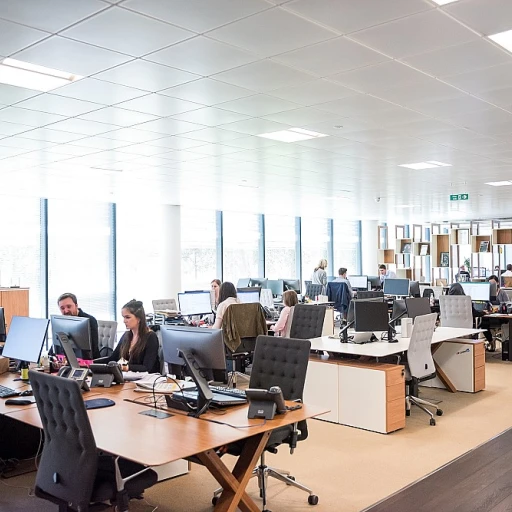
The Urgency of Sustainable Office Management
Recognizing the Need for Eco-Conscious Office Environments
The conversation around sustainable office management is not just buzz; it's a critical pivot we must all consider. Offices are more than just physical spaces where we conduct business; they're ecosystems that consume resources and produce waste. According to the Environmental Protection Agency, commercial buildings account for 17% of US greenhouse gas emissions. With statistics like these, it's no wonder that there's an urgent need to explore green practices that can lead to a more sustainable future for office management.
Carbon Footprint: A Critical Component of Your Office's Environmental Impact
Understanding the carbon footprint of your office is the first step towards making impactful changes. It entails all the greenhouse gas emissions that result from both direct and indirect office activities. A report by the Carbon Trust highlights that energy consumption in office buildings can be reduced by as much as 60% using existing technologies. When we think of innovative technologies, it's not just about groundbreaking inventions but also about applying existing solutions in smarter ways to reduce our corporate carbon footprint.
Aligning Office Procedures with Global Sustainability Targets
In alignment with global sustainability targets like the Paris Agreement, office managers can spearhead initiatives that actively reduce their environmental impact. Engaging office staff in sustainable development practices is not just beneficial for the planet but can also impact the company's bottom line positively. For example, if employee engagement in sustainability initiatives can improve energy savings and operational efficiency, leading to significant cost reductions.
Integrating Green Practices for Long-Term Benefits
Integrating green practices goes beyond recycling bins and LED lights. It encompasses comprehensive strategies such as sourcing sustainable materials, implementing strict waste management protocols, and encouraging a culture of conservation. Forbes reports that incorporating sustainable practices improves brand reputation and attracts customers and talent who prioritize environmental responsibility.
As we delve into the specifics of transforming your office space with green practices, innovative technologies, employee engagement, and effective environmental progress tracking, remember that your journey towards sustainability can inspire others and have a rippling effect far beyond your office walls.
Green Practices to Transform Your Office Space
Implementing Eco-Conscious Workspaces
Transforming your office into an environmentally friendly haven isn't just a noble endeavor—it's a critical move towards sustainability. By adopting green practices, a company can significantly reduce its carbon footprint. For instance, incorporating live plants boosts air quality and workplace wellness, according to a study by the University of Exeter, which found that employees were 15% more productive when houseplants were added to workplaces.
Choosing Sustainable Materials and Furnishings
When it comes to office furnishings, the choices can make a world of difference. Opting for sustainable materials like bamboo or recycled metals not only minimizes environmental impact but also sets a precedent for eco-conscious decision-making. A Harvard Business Review report highlighted that organizations perceived as sustainable saw a boost in their performance, driving home the point that eco-friendly initiatives are not just good for the planet, but good for business too.
Energy Efficiency: A Key to Green Transformation
Energy-saving practices, such as utilizing LED lighting or installing smart thermostats, play a significant role in building a sustainable office. According to the U.S. Department of Energy, LED lighting uses at least 75% less energy and lasts 25 times longer than traditional incandescent lighting. By embedding these energy-efficient technologies within your office, you're not only contributing to a greener future but also cutting down on operational costs—a true win-win scenario.
Reducing, Reusing, and Recycling in the Office
Adopting a 3Rs policy (Reduce, Reuse, Recycle) is emblematic of a commitment to conservation and waste management. Introducing comprehensive recycling stations, encouraging double-sided printing to reduce paper use, and promoting reusable bottles and mugs can substantially diminish your office's waste output. It’s been reported by the Environmental Protection Agency that the average office worker uses 10,000 sheets of copy paper each year, signaling a massive opportunity for reduction.
Cultivating a Green Mindset Among Staff
Creating a culture of sustainability within the workplace is essential. Training and awareness programs can empower employees to make more ecologically responsible choices. Business magnate and philanthropist Richard Branson once said, "A company is people ... employees want to feel proud of the organization they work for." By engaging employees in green initiatives, you nurture a shared pride in sustainable practices that can resonate throughout the corporate structure.
Discover how to unlock the secrets to an eco-friendly workplace and further transform your office into a model of environmental stewardship.
Innovative Technologies Reducing the Corporate Carbon Footprint
Incorporating Smart Energy Solutions
Embracing smart energy solutions is a powerful strategy for reducing the carbon footprint within the modern office. A study on energy efficiency by the International Energy Agency (IEA) suggests that buildings, including offices, account for nearly 40% of global energy-related carbon emissions. Leveraging technologies like automated lighting, smart thermostats, and energy-efficient appliances, helps to cut down on unnecessary power usage. Specific examples include motion-sensor LED lighting which, according to the U.S. Department of Energy, can save approximately 50% in lighting energy consumption.
Implementing Cloud Computing and Virtual Conferences
The surge in remote work has highlighted the potential for cloud computing and virtual conferences to minimize office carbon emissions. Data from the Carbon Trust indicates that virtual meetings can reduce carbon emissions by avoiding business travel. A traditional meeting might require participants to travel by car or plane, but video conferencing virtually eliminates that need, demonstrating both a reduction in carbon footprint and overall operational costs.
Transitioning to a Paperless Environment
The push for a paperless office not only streamlines workflow but also serves sustainable initiatives. In the United States alone, over 12.1 trillion sheets of paper are used by offices annually, as reported by the Environmental Protection Agency (EPA). Transitioning to digital documentation systems and using electronic signatures can significantly reduce this paper dependency. As a result, office managers are not just saving trees but reducing the energy used in paper production and waste management.
Optimizing Resource Management with AI and IoT
Advanced technologies such as Artificial Intelligence (AI) and the Internet of Things (IoT) are transforming resource management. AI can predict and adjust energy consumption based on usage patterns, while IoT devices can monitor and control a myriad of office elements in real-time. A case study from the American Council for an Energy-Efficient Economy highlights businesses that have seen energy usage reductions of up to 20% with the adoption of these technologies.
Investing in Renewable Energy
The trend towards renewable energy sources such as solar, wind, and biomass is picking up pace in office environments. Renewable energy statistics by the International Renewable Energy Agency (IRENA) forecast a substantial increase in corporate sourcing of renewables by 2050. Installing solar panels or signing up for a green energy provider are effective ways for office managers to ensure a renewable, sustainable energy supply for their operations.
Employee Engagement in Sustainable Development
Turning Employees into Sustainable Office Champions
In the quest for a greener office, the rallying of the workforce plays an instrumental role. Statistics show that when employees are actively involved in sustainability measures, businesses can see a significant decrease in their carbon footprint. For instance, a study by the Environmental Protection Agency indicates that simple acts like recycling can reduce an office's waste by over 30%. Engaging employees through educational workshops and eco-friendly challenges not only bolsters morale but cultivates a culture of environmental responsibility that permeates every aspect of office life.
Instilling Green Habits through Corporate Policy
By weaving sustainability into the fabric of company policies, office managers can encourage employees to adopt eco-friendly habits. Recent surveys suggest that 70% of employees are more likely to work for a company with a strong environmental agenda. Implementing policies like paperless meetings and mandatory recycling can make a substantial difference. Corporate incentives for green commuting alternatives have also proven effective in reducing carbon emissions and promoting sustainable living among the workforce.
Leveraging Teamwork for Creative Sustainability Solutions
The adage 'two heads are better than one' particularly rings true when considering sustainability in the office environment. Collaboration among team members can lead to innovative ideas that propel a company towards its eco-goals. For example, hosting brainstorms to reduce energy consumption or design more efficient workflows can tap into the diverse experiences of your team, ultimately leading to a reduction in the office's carbon footprint.
Monitoring and Reporting: Tracking Your Office's Environmental Progress
Smart Strategies for Environmental Accountability in the Workplace
As businesses strive to minimize their environmental impact, the importance of monitoring and reporting on green initiatives becomes paramount. According to a 2020 study, companies that implemented sustainable practices saw a 10% rise in public perception, highlighting the dual benefit of environmental responsibility and enhanced company image. Establish a routine for collecting data on energy consumption, recycling rates, and carbon emissions. This not only reflects a commitment to transparency but also provides invaluable insights into the efficacy of your sustainability strategies.
Tools for Measuring Your Office's Green Performance
With the increasing focus on sustainability, a variety of tools have emerged to help office managers track their progress. Software applications like 'Eco-Tracker' and 'GreenAudit' now offer user-friendly interfaces that simplify the process of setting benchmarks and measuring improvements. These tools can automate the collection of data, saving time and reducing the potential for human error. Statistics indicate that the use of such digital solutions can improve data accuracy by up to 75%, ensuring more reliable reporting.
Engaging Stakeholders Through Impactful Reporting
Reporting on sustainability is not just about complying with regulations; it's about engaging stakeholders and driving change. Develop comprehensive reports that include vivid charts and clear statistics to communicate your office's environmental progress. A survey of business leaders showed that 65% consider sustainability reports essential for decision-making. Through transparent reporting, offices can build trust with clients, motivate employees, and attract investors who are keen on supporting companies with a solid green agenda.
Aligning Green Goals with Industry Standards
Align your office's sustainability goals with industry standards and frameworks such as the Global Reporting Initiative (GRI) or the Carbon Disclosure Project (CDP). This alignment ensures that your efforts are calibrated against recognized benchmarks, enhancing your office’s credibility. In 2021, reports showed that companies adhering to these standards reduced their environmental impact by an average of 12%, emphasizing the effectiveness of industry-aligned efforts.
Utilizing Data-Driven Decisions to Forge a Greener Path
Use the collected data to make informed decisions for future sustainability projects. It's not enough to collect data; what you do with it can define your office's environmental journey. Analyze trends, identify areas that need improvement, and set realistic targets for reducing your carbon footprint. For example, if your office's energy use spikes in winter, investing in better insulation could be a strategic move. A recent study found that offices that utilize data-driven insights can reduce energy expenses by up to 20% annually.


-large-teaser.webp)
